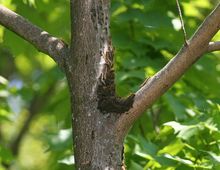The beginning of the eastern tent caterpillar egg hatch was reported March 23 in Scott County. According to Lee Townsend, University of Kentucky College of Agriculture, Food and Environment extension entomologist, the tiny larvae will continue to emerge over the next two weeks from eggs laid last summer on flowering wild cherry, cherry, apple and related trees.

A group of tent caterpillers in a tree
Horse owners should plan to move pregnant mares from areas where flowering wild cherry, cherry, apple and related trees are abundant to minimize the chance of exposure to the caterpillars.
© 2015 by Dave Pape
Consumption of large numbers of caterpillars by pregnant mares precipitated staggering foal losses in the Mare Reproductive Loss Syndrome outbreak that peaked in 2001. MRLS can cause late-term foal losses, early- and late-term fetal losses and weak foals.
Studies by UK researchers revealed that horses will inadvertently eat the caterpillars, and the caterpillar hairs embed into the lining of the alimentary tract. Once that protective barrier is breached, normal alimentary tract bacteria may gain access to and reproduce in sites with reduced immunity, such as the fetus and placenta.
Horse owners and farm managers with pregnant mares should begin to monitor fence lines containing wild cherry trees in about two weeks for small tents produced by developing caterpillars.
If practical, farms should plan to move pregnant mares from areas where these trees are abundant to minimize the chance of exposure to the caterpillars. The potential is greatest when the mature tent caterpillars leave trees and wander to find places to pupate and transform to the moth stage.
The eastern tent caterpillar spends the winter as tiny, fully-developed insects in distinctive egg masses that encircle twigs of wild cherry and related trees. It is one of the first insects to become active in the spring and is well adapted to survive Kentuckyâs erratic winter and early spring weather.
âThis is a hardy insect, so it is unlikely that our winter temperatures caused much mortality,â Townsend said. âStudies have shown that caterpillars in the egg can withstand temperatures down to 31 below zero Fahrenheit.â
Populations of eastern tent caterpillars have been climbing over the past few years. This trend is likely to continue, he said, producing locally high numbers in some areas. The rise in numbers is normal and mirrors the cyclical aspects of insect populations in general.
According to Townsend, eastern tent caterpillar cycles are roughly 10 years in length. After two or three high years, the numbers usually drop again due to diseases or natural enemies.
When mature, the large, hairy caterpillars wander from their developmental sites along fence lines.
To get rid of active caterpillars, Townsend recommends pruning them out and destroying the nests as they are seen, if practical. Any one of several biorational insecticides registered for use on shade trees can also be used to treat as needed. Spot treatments to the tents and/or the foliage around them can be applied according to label directions, which vary by product.
Information about assessing trees for egg masses can be found at http://www2.ca.uky.edu/entomology/entfacts/ef449.asp.
